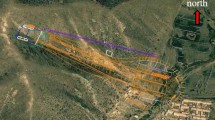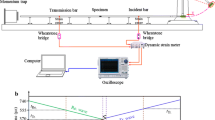Abstract
Understanding of impact characteristics is the basis of studying the hydrodynamic characteristics of water–rock flow. The impact and vibration characteristics of water-stone flow on protective structures were comprehensively studied in the research presented in this paper using an indoor large-scale test. Five groups (A–E) of graded crushed stone particles, combined with six levels of solid–liquid ratio (0.01, 0.05, 0.10, 0.15, 0.20, and 0.25) were used in this testing program. The spectrum and the energy spectrum of impact acceleration signal were analyzed and pertinent information was extracted using wavelet theory. The test results showed that the auto correlation curve of the impact signal had a maximum value when the delay of impact acceleration signal (τ) was zero, and the curves on both sides of the instant of impact were non-periodic, indicating that the periodicity of the signal was poor. However, two observed impulse signals were stable and they highly correlated. Maximum energy of the shock signal was located in the low frequency within an approximate coefficient a8 band, and the maximum amplitude of each band decayed from a low frequency (a8: 0–0.3905 Hz) to an high frequency (d5: 3.125–6.25 Hz), while the attenuation amplitude decreased gradually. The real impact acceleration signal of the water-stone flow was in the band of 0–6.25 Hz, and the rest were a result of signal noise. The research provided a new and innovative methodology of studying the impact characteristics of such debris flow, and also provided some significant guidance for the design of water-stone flow disaster prevention structures.












Similar content being viewed by others
Data availability
The acquisition of experimental data is obtained by the physical model experiment conducted in a debris flow simulation laboratory at Zaozhuang University (Shandong, China). The experimental results are repeatable. Relevant scholars can use similar experimental models or visit the laboratory to further verify the reliability of the experimental data.
References
Chechelnitsky VV, Makarov SA, Dobrynina AA (2018) The Disastrous water-stone flow in the Kyngarga River (Republic of Buryatia) on June 27–29, 2014, according to Seismological Data. Doklady Earth Sci 481(PT.2):1108–1112
Chen HK, Xian XF, Tang HM, Zhang YP, He XY, Wen GJ, Tang L (2012) Energy distribution in spectrum of shock signal for non-viscous debris flow. J Vib Shock 31(14):56–59
Chen XH, Sun HY, Mei C, Zhang WJ, Qian WJ (2016) Flow control of water-stone flow star. Mountain Res 34(2):194–199
Cui P (2009) Advances in debris flow prevention in China. Sci Soil Water Conserv 7(5):7–13
Ding P, Tao LJ, Yang XR, Zhao J, Shi C (2019) Three-dimensional dynamic response analysis of a single-ring structure in a prefabricated subway station. Sustain Cities Soc 45:271–286
Guo S, Xu P, Zheng Z, Gao Y (2014) Estimation of flow velocity for a debris flow via the two-phase fluid model. Nonlinear Process Geophys Discuss 1:999–1021
He XY, Tang HM, Chen HK (2014) Experimental study on impacting characteristic of debris flow considering different slurry viscosities, solid phase ratios and grain diameters. Chin J Geotech Eng 36(5):977–982
He XY, Chen HK, Tang HM (2016) Experimental study on the energy distribution characteristics of impacting signals of debris flow considering the slurry viscosity and particle collision. J Vib Shock 35(6):64–69
Hu KH, Wei FQ, Li Y (2011) Real-time measurement and preliminary analysis of debris-flow impact force at Jiangjia Ravine, China. Earth Surf Proc Land 36:1268–1278
Ma QH, Yin HX, Liu YF, Niu BB (2016) Model study on catastrophe characteristics for initiation debris-flows in Taihang Mountain Area. Yellow River 38(11):5–8
Nearing MA, Simanton JR, Darrell NL, Bulygin SJ (1999) Soil erosion by surface water flow on a stony, semiarid hillslope. Earth Surf Proc Land 24(8):677–686
Savage SB (1979) Gravity flow of cohesionless granular materials in chutes and channels. J Fluid Mech 92(1):53–96
Strutinskiy V, Yakhno O, Machuga O, Hnativ I, Hnativ R (2018) Analysis of interaction between a configurable stone and a water flow. East-Eur J Enterp Technol 6(96):14–20
Tang JB, Hu KH, Zhou GD, Chen HY, Zhu XH, Ma C (2013) Debris flow impact pressure signal processing by the wavelet analysis. J Sichuan Univ (eng Sci Ed) 45(1):8–13
Wang LF, Zhu HZ, Song NN, Zou Z, Yao CY (2019) Impact signal dynamic characteristics of energy dissipation shed tunnel. J Traffic Transp Eng 19(5):33–41
Wang H, Chen HK, Zhang JH, Wang Q (2020) Experimental study on influence of impact angle of Mounta torrent on distribution rule of impact force on subgrade. J Chongqing Jiaotong Univ (nat Sci) 39(5):97–102
Wu WL, Liu XL, Guo JQ, Sun FY, Huang X, Zhu ZG (2021) Upper limit analysis of stability of the water-resistant rock mass of a karst tunnel face considering the seepage force. Bull Eng Geol Environ 80:5813–5830
Xu YN, Liang ZY, Su XB, Wang L (2000) Physical modeling of debris flow in the experiment flume. J Nat Disasters 9(4):105–110
Yang M, Ma DT, Chen Y (2014) An approach about water stone flow hazards occurred in July 18th, 2013 in Maoniuping rare earth mining area in Mianning. Sichuan Mt Res 32(6):732–738
Yang Q, Ma H, Ji XR (2014) Parameter extraction of traffic noise by analysis of auto-correlation function and interaural cross-correlation function. Acta Acust 39(5):624–632
Zhang YP (2009) Signal identification method to debris flow impaction. Master's thesis, Chongqing Jiaotong University, Chongqing
Zhang Y, Li GW, Yang JH, Guo XF (2019) Application of improved wavelet threshold function in impact acceleration signal processing. Chin J Sens Actuators 32(3):405–410
Zhuang HY, Hu ZH, Wang XH, Chen GX (2015) Seismic responses of a large underground structure in liquefied soils by FEM numerical modelling. Bull Earthq Eng 13:3645–3668
Acknowledgements
This research was supported by the National Program on Key Research Project of China (Grant No. 2018YFC1505405).
Author information
Authors and Affiliations
Corresponding author
Ethics declarations
Conflict of interest
The authors declare that they have no conflict of interest.
Additional information
Publisher's Note
Springer Nature remains neutral with regard to jurisdictional claims in published maps and institutional affiliations.
Rights and permissions
About this article
Cite this article
Liao, X., Chen, H., Zhang, J. et al. Experimental study on impact signal frequency spectrum and energy distribution characteristics of water-stone flow. Geotech Geol Eng 40, 1739–1750 (2022). https://doi.org/10.1007/s10706-021-01990-x
Received:
Accepted:
Published:
Issue Date:
DOI: https://doi.org/10.1007/s10706-021-01990-x




